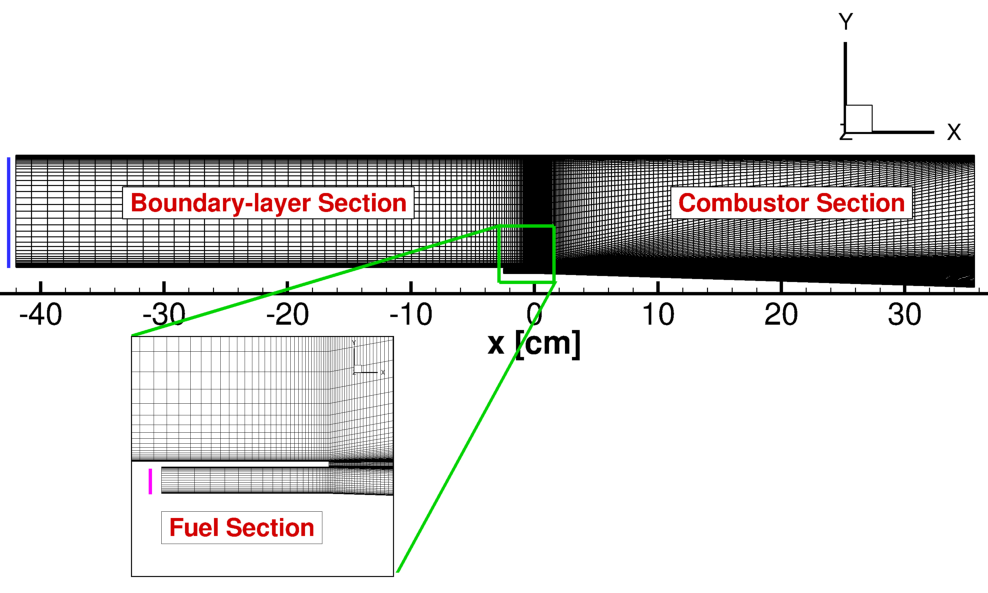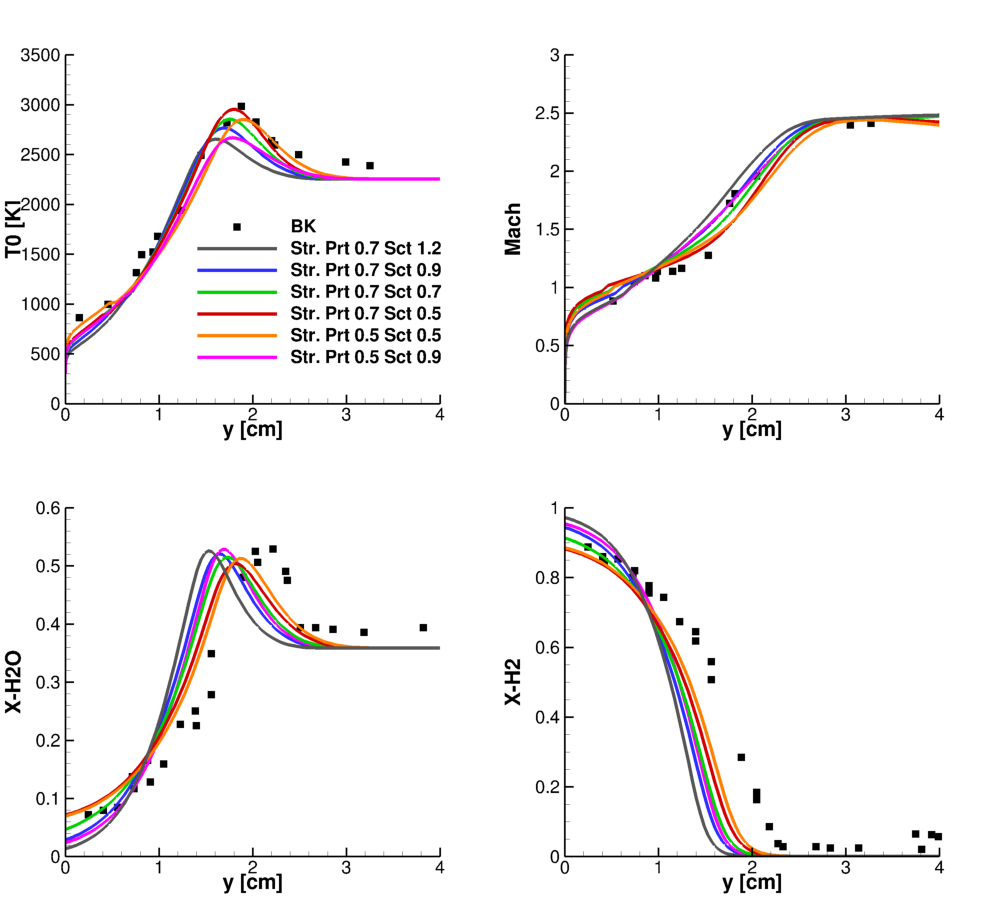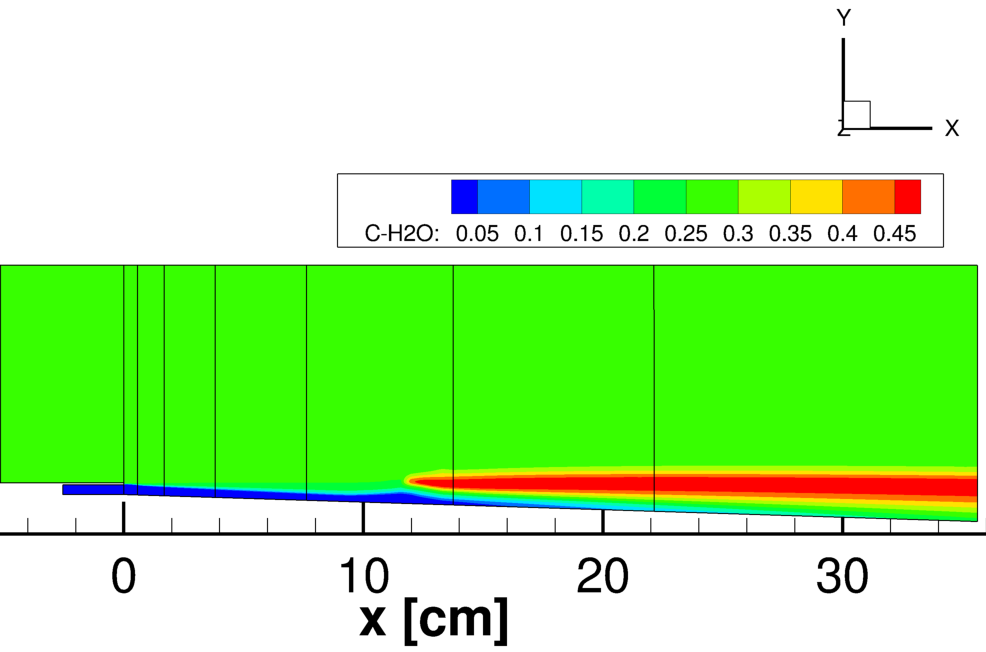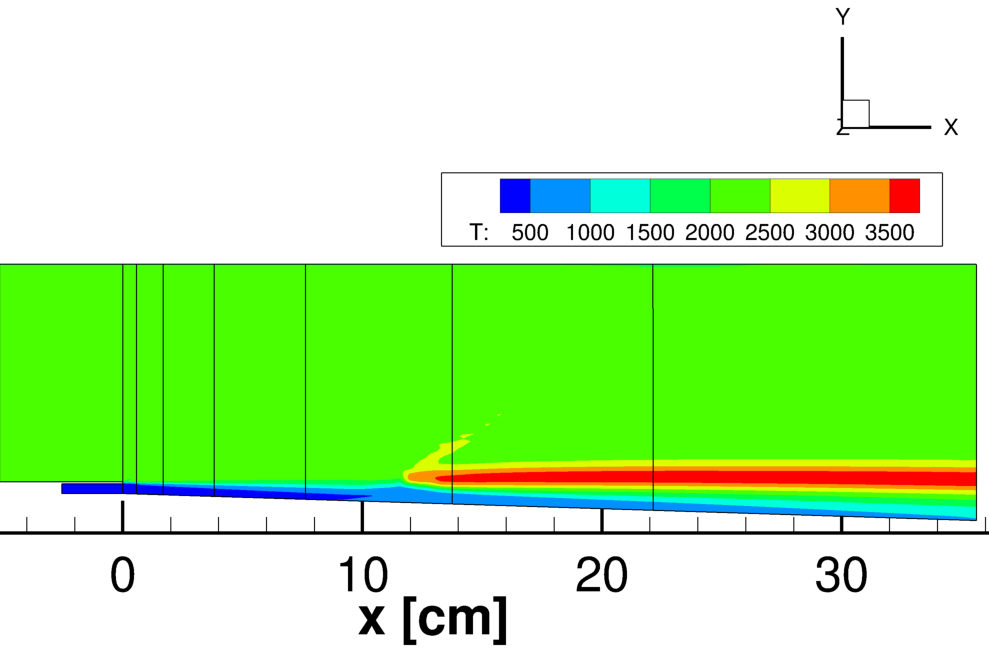
Figure 1: Schematic of the Structured Mesh.
This study focuses on a finite-rate, hydrogen-air chemical reactions occuring in Mach 2.44 vitiated air. The ignition point and species mole fraction values of the combustion products are investigated. The Wind-US (version 4.107) results are compared to the experimental data presented by Burrows and Kurkov (Ref. 1). In the current study, only structured algorithm was used. Unstructured algorithm will be investigated as a later date.
A 10-zone two dimensional structured mesh was generated to model the boundary-layer, combustor, and fuel sections. The boundary-layer section was 81 x 81 grid points and partitioned into two zones, the combustor section was 121 x 145 grid points and partitioned into 7 zones, and the fuel zone was 21 x 41 grid points (not partitioned). This mesh was partitioned into 10 zones in x-direction to accelerate convergence using MPI. Although the mesh was split using a commercial grid generation tool, cfsplit tool provided with Wind-US can also be used to do the same.

Figure 1: Schematic of the Structured Mesh.
The structured grid is provided below in the common file format. The coordinates are in units of inches.
| Structured |
|---|
| run.cgd |
In this case, the chemistry file h2-air-9sp-3287.chm was used for the finite-rate calculations. The chemistry model was obtained from the Peters and Rogg hygrogen-air checmical kinetics, which involved 13 species and 27 reactions. The model was simplified by removing carbon species and relevant reactions to obtain 9 species and 18 reactions model. The model is included in the Wind-US version 4.0 release package.
All walls were set to a uniform 536 Rankine. The freestream and Hydrogen initial consitions are provided in the table below:
| Freestream | Hydrogen | |
|---|---|---|
| Mach | 2.44 | 1.0 |
| Pressure (psi) | 14.7 | 14.7 |
| Temperature (R) | 2286 | 457.2 |
The arbitrary inflow boundary condition (BC) was used for both inflows, viscous wall was employed for all walls, and the outflow boundary condition was used at the exit (forcing extrapolation of the pressure).
The computations were performed using the time-marching capabilities of Wind-US to march to a steady-state (time asymptotic) solution. Local time stepping as used at each iteration. The time-marching was performed until the convergence criteria was achieved, which was a combination of Navier-Stokes L2 Norm and species mole fraction along the exit plane at 35.6 cm. The solution was obtained for a total of 20,000 cycles at CFL number of 1.0 in the following manner manually (SOLVER-STAGES was not used):
| first-order, 2 2 0 sequence | 2000 cycles |
|---|---|
| second-order, 2 2 0 sequence | 2000 cycles |
| second-order, 1 1 0 sequence | 4000 cycles |
| second-order, 0 0 0 sequence | 12000 cycles |
Input file is provided below.
| Structured |
|---|
| run.dat |
The Wind-US structured flow solver created the following output files:
| Structured |
|---|
| run.cfl |
| run.lis |
The log of the L2 Norm was observed for convergence. The charts are omitted here but can be produced using the mon_res script. The script should be executed in the folder with the run.lis file.
Total temperature, Mach number, and species mole fractions for H2O and H2 are compared to the experimental data in Figure 2. Turbulent Prandtl and Schmidt numbers are varied to obtain best match to the exit profiles as well as the onset of ignition. The motivation of turbulent Prandtl and Schmidt number study can be found in the work of Engblom et al. Their work also explains the physical implication of turbulent Prandtl and Schmidt numbers and their importance in reacting flows. In another useful reference, Vyas et al. has applied Wind-US to obtain scramjet predictions using similar settings.
The experimental data can be downloaded here. The structured solution was post processed using post_process.

Figure 2: Total temperature, Mach number, and species mole
fractions for H2O and H2 at the exit plane.
The results show that turbulent Prandtl and Schmidt numbers of 0.7 and 0.7, respectively, provided a good match to the experimental exit profiles. However the ignition onset was predicted at approximately 14 cm (Figure 3 and 4), assuming that ignition occurs after temperature reaches 3500 Rankine. The experimental onset of ignition for freestream temperature of 2286 Rankine was 18 cm. Increasing turbulent Schmidt number would delay combustion, however it also resulted in less accurate match of predicted exit profiles to the experimental data. Further analysis is necessary to study this behavior, however for the unit/validation purpose the current results would suffice.

Figure 3: H2O mass fractions contours in the x-y plane.

Figure 4: Static temperature contours in the x-y plane.
Burrows, M. C. and Kurkov, A. P., "Analytical and Experimental Study of Supersonic Combustion of Hydrogen in a Vitiated Airstream," NASA-TM-X-2828, September 1973.
Engblom, W. A., Frate, F. C., and Nelson C. C., "Progress in Validation of Wind-US for Ramjet/Scramjet Combustion," AIAA-2005-1000, January 2005.
Vyas, M. A., Engblom, W. A., Georgiadis, N. J., Trefny, C. J., and Bhagwandin, V. A., "Numerical Simulations of Vitiation Effects on a Hydrogen-fueled Dual-mode Scramjet," AIAA-2010-1127, January 2010.
This case was created on December 28 , 2014 by Manan Vyas, who may be contacted at
NASA Glenn Research Center
21000 Brookpark Road, MS 5-12
Cleveland, Ohio 44135
Phone: (216) 433-6053
e-mail: manan.vyas@nasa.gov